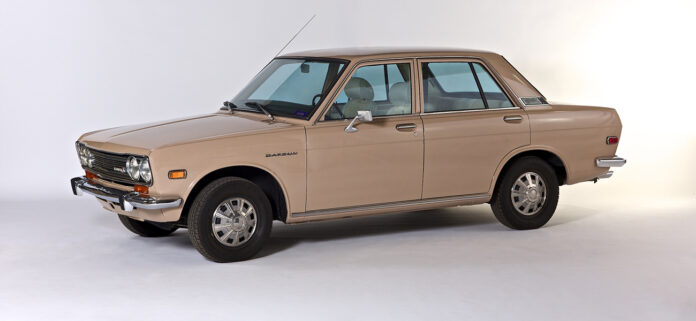When the Datsun 411 was replaced by the Datsun 510 in 1968, the Italian-designed body was replaced, but the blueprint for all future Nissan sports sedans was set. The Datsun 510 became almost unbeatable on the race track and a popular alternative to European sports sedans in garages all over America. Road & Track magazine named the 510 “one of the most important cars of the 20th Century.” The Nissan Heritage Collection, located in the basement of the Lane Motor Museum in Nashville, contains several production and concept vehicles significant to the brand’s U.S. operations. This is the second article in a series that focuses on select vehicles in the collection. In 1958, Nissan began selling Datsun-branded cars in the U.S. when the Datsun 1200 sedan arrived stateside. Yet, despite strong domestic and European competition, Datsun models had difficulty making a significant impact on the U.S. car market until the Datsun 510 arrived a decade later. Legendary Nissan executive Yutaka Katayama – nicknamed “Mr K” and widely known as the father of the Z sports car – played a significant role in the 510’s success. Benchmarking European competition, Katayama convinced leadership that Nissan needed a car with higher design and performance standards if the Japanese brand was to survive in the ultra-competitive U.S. market. The Datsun 510 eventually hit the U.S. market in 1968. Initially offered as a sedan and a wagon, a two-door coupe later joined the lineup. The 510 featured sporty yet comfortable independent suspension and a sprightly 96-horsepower, 1.6-liter inline-four engine. Reviewers appreciated the performance of the Datsun 510 and compared it favorably to its European rivals, albeit at a more accessible cost. Over its short production run until 1973, the 510 was a major success, with 300,000 U.S. sales. In 1971, 510 models accounted for over 40% of Nissan’s U.S. sales. The car helped put the Japanese brand on the map in the competitive American car market and was a boon for Nissan’s small but growing dealer network. Furthermore, the 510 became a significant contender in the world of motorsport, with its #46 race car clinching the SCAA 2.5-liter Trans Am Championship in 1971 and 1972. It was Nissan’s first professional racing win, followed by an array of racing successes in international competition. The 510 remains revered in club racing today. The 510 paved the way for generations of Nissan sedans to come, representing the first in a long series of “4-Door Sports Cars.” Its lineage can be traced to the Datsun 810 Maxima, kicking off over four decades of the Nissan Maxima as the company’s flagship sedan. Nissan continues to prioritize sedans that provide technology, style, and fuel efficiency at accessible prices, such as the Altima, Sentra, and Versa. Today, the Nissan Heritage Collection houses three 510 models: a Datsun 510 coupe race car built by Brock Racing Enterprises and returned to Nissan after its last racing season; a 1972 Datsun 510 sedan purchased from its previous owner in 2013; and a 1972 Datsun 510 wagon, which was donated to Nissan according to the last will and testament of a newspaper writer who had a strong relationship with Yutaka Katayama. The Nissan Heritage Collection may only be visited through a private tour. Photo credit: All photos herein are the property of Nissan and were published by MyclassicNEWS with the brand’s permission and consent. All content herein, other than property published by permission, belongs to myclassicnews.com, and any reproduction, other than normal social media sharing, is strictly prohibited. Copyright © myclassicnews.com. For reprint permission, contact us at rick@groupduncan.com.
“My Classic News on the Datsun 510”

RELATED ARTICLES


